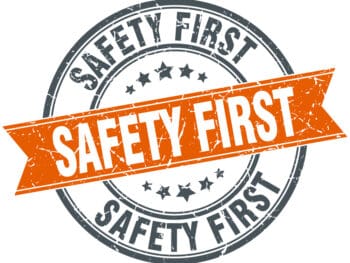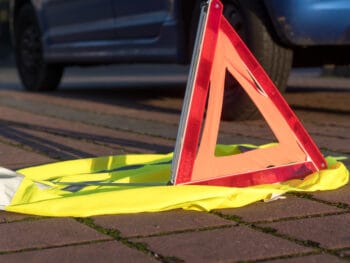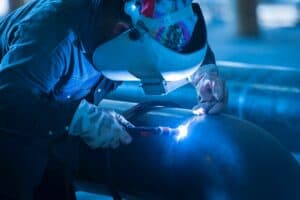One of the most common causes of workers compensation claims is the improper lifting of a heavy object by an employee. It is also one of the easiest workers compensation claims to avoid. When an employee injures a back, it is usually not the heavy weight, but the method of lifting the weight that was improper. These back injuries can be avoided. The teaching of proper lifting techniques, to any employee who may be called upon to physically move objects, is an essential part of any good safety program.
There are at least 6 common things that employees do that cause them to hurt their back. They are (this is not an all inclusive list)
- Twisting while lifting
- Holding the object too far away from the body
- Lifting with the back bent
- Contorting the body to lift in an unnatural way
- Losing their balance while lifting
- Not coordinating their lift with other co-worker(s)
Twisting while Lifting
When a heavy object needs to be moved from a floor or other level to a higher level, the employee will often be paralleled to the higher level when the object is picked up and will have to twist to set the object on the higher level (shelf, cart, conveyor belt, etc.). The employee should approach the object perpendicular to the higher level where the object is going to be placed, with the employee, the object and the higher level in a straight line. This puts the object in the middle between the employee and the higher level, allowing the employee to lift the object without twisting. It also allows the employee to have the head facing straight forward to keep all parts of the spine in a straight line.
Holding the Object Too Far from the Body
Sometimes employees just do not want to get dirty. If the object is dirty, greasy, oily, etc., the employee may be inclined to try to lift the object while holding the object away from the body. This is difficult to do with light objects and a recipe for an injury with heavy objects. The further the object is from the body, the harder it is too lift and the more strain it places on the body. The employees need to be taught to hold the object they lift as close to the body as possible to avoid strain on the back.
Lifting with the Back Bent
When employees have not been taught the proper lifting techniques for heavy weights, they are often inclined to keep the legs straight and the back bent. This is backwards of the proper way to lift. The employee should be facing the object with the feet shoulder width apart. The employee should keep the back straight and bend the knees to lower the body closer to the object. This allows the employee to lift the object with the strength of the legs instead of placing tremendous strain on the back by trying lift with the back bent.
Contorting the Body to Lift in an Unnatural Way
Often the box of supplies, or bucket of parts or other heavy object is surrounded by other objects that are in the way of the employee trying to lift the object needed. When the employee contorts the body to lift a load in a cluttered area, the worker is inviting injury. While it takes a little longer, the employee should be taught to move other items out of the way (using proper lifting techniques) before trying to lift a heavy object. The employee should be sure the area around the object and the pathway from the object is clear prior to lifting it.
Losing Balance While Lifting
There are different ways the employee can lose his balance while lifting a load. Common mistakes include placing the feet too close together, picking up an irregularly shaped object where the load is uneven, trying to pick up a stack of two or more objects at the same time, or trying to pick up an object that is too heavy. The employees should be taught that the feet need to be at least shoulder width apart, or slightly wider. If the load is unevenly balanced, the employee should redistribute the weight of the load if more than one object, or to get someone to assist in lifting the object if the weight of the object is unevenly distributed.
Not Coordinating the Lift with Others
When two or more people are lifting a heavy object at one time, not only is there a strong probability of a back injury if done incorrectly, the employees may badly smash toes. When it takes more than one person to lift an object, and a forklift is not option, it is imperative that all the parties to the lift communicate where they are holding or grasping the object, where they are moving the object to, and when they will lift simultaneously.
Proper lifting can easily be taught to all employees involved in any type of manual labor. The basic points each employee needs to know include:
- Keep the back straight at all times
- Keep the load as close to the body as possible
- Keep the feet at least shoulder width apart with the toes turned slightly outward
- Bend the knees, not the back
- Keep the object to be lifted directly in front of you to avoid twisting
- Keep your head forward facing the object
- Breathe out as you lift
Author Michael Stack, Principal, COMPClub, Amaxx LLC. He is an expert in workers compensation cost containment systems and helps employers reduce their work comp costs by 20% to 50%. He works as a consultant to large and mid-market clients, is co-author of Your Ultimate Guide To Mastering Workers Comp Costs, a comprehensive step-by-step manual of cost containment strategies based on hands-on field experience, and is founder of COMPClub, an exclusive member training program on workers compensation cost containment best practices. Through these platforms he is in the trenches on a working together with clients to implement and define best practices, which allows him to continuously be at the forefront of innovation and thought leadership in workers’ compensation cost containment. Contact: mstack@reduceyourworkerscomp.com.
©2016 Amaxx LLC. All rights reserved under International Copyright Law.
Do not use this information without independent verification. All state laws vary. You should consult with your insurance broker, attorney, or qualified professional.







